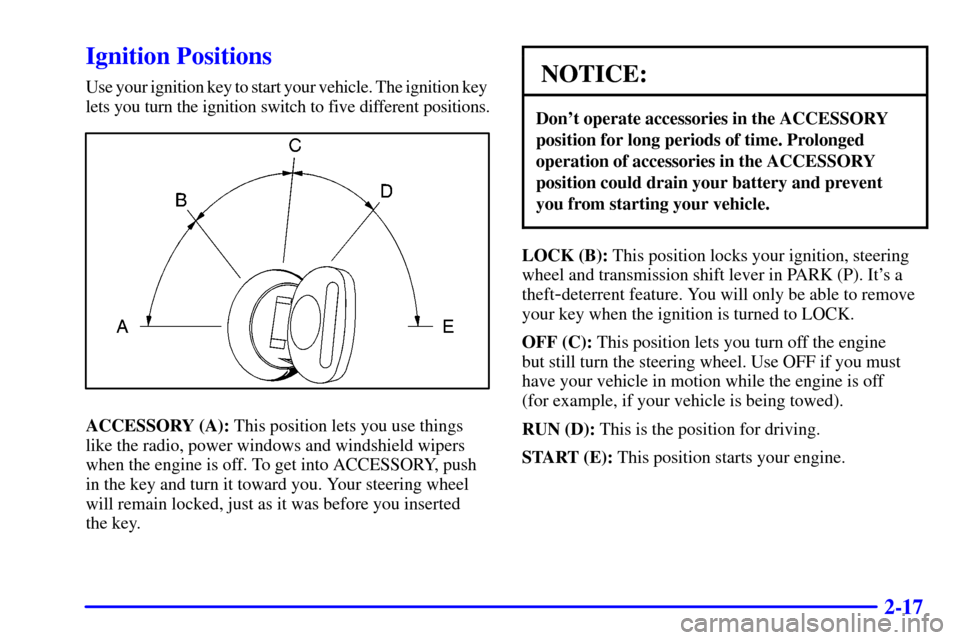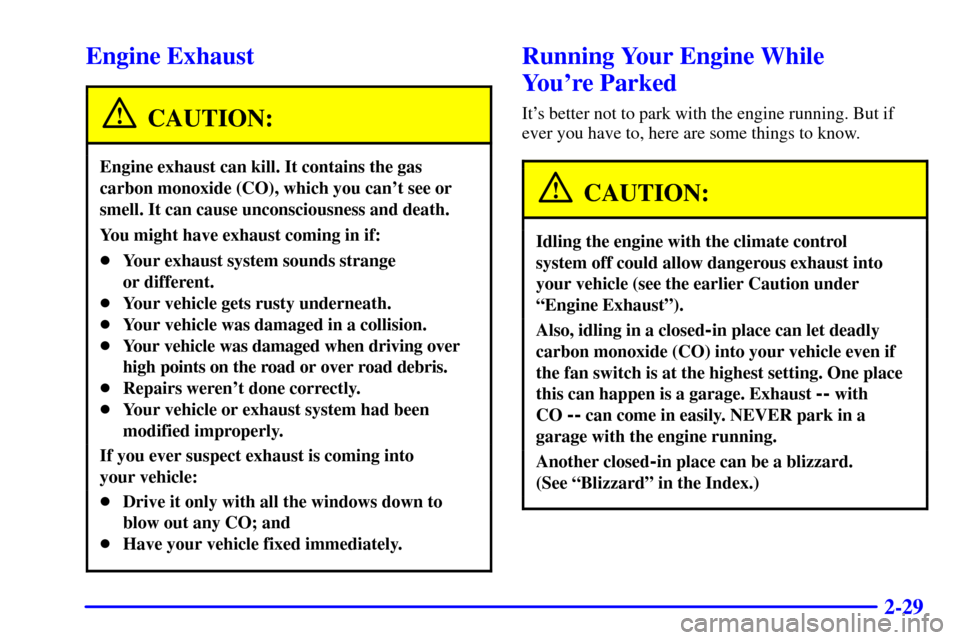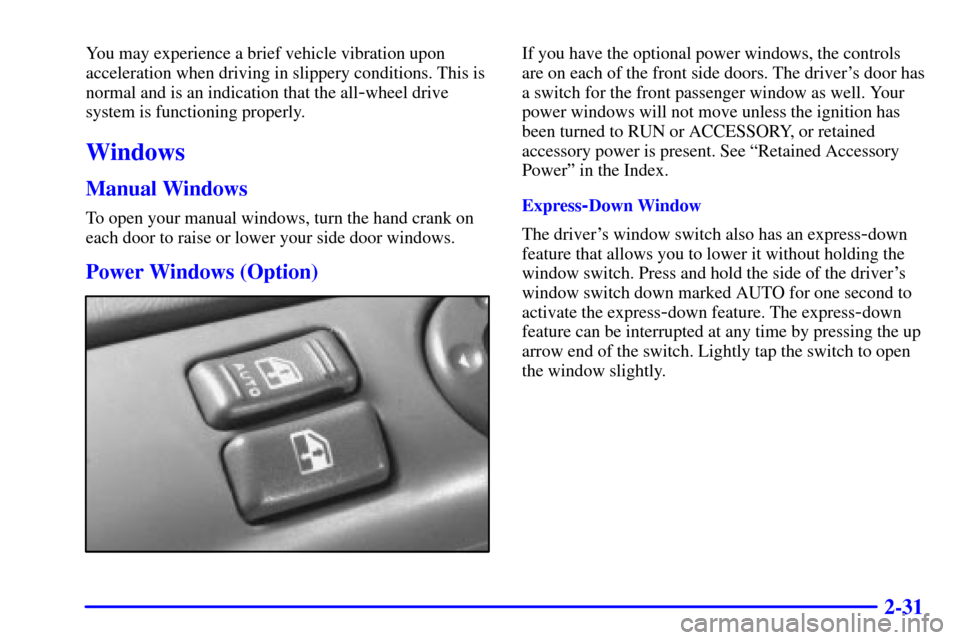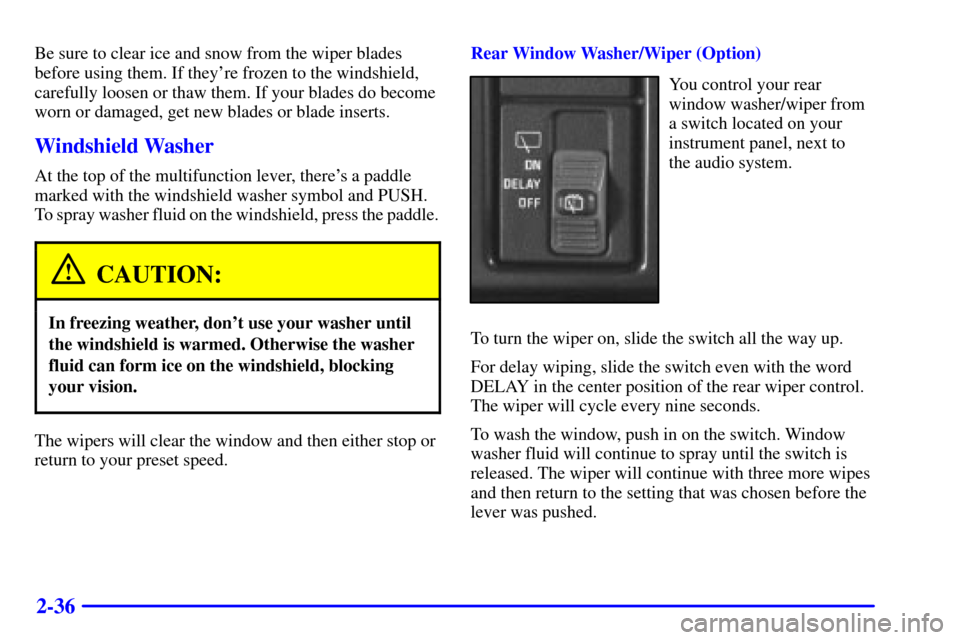Page 89 of 391

2-14
Hatch
CAUTION:
It can be dangerous to drive with the rear
swing
-out windows, rear hatch or rear doors open
because carbon monoxide (CO) gas can come into
your vehicle. You can't see or smell CO. It can
cause unconsciousness and even death.
If you must drive with the rear swing-out
windows, rear hatch or rear doors open or if
electrical wiring or other cable connections must
pass through the seal between the body and the
rear swing
-out windows, rear hatch or rear doors:
�Make sure all other windows are shut.
�Turn the fan on your heating or cooling
system to its highest speed with the setting
on anything but MAX A/C. That will force
outside air into your vehicle. See ªComfort
Controlsº in the Index.
�If you have air outlets on or under the
instrument panel, open them all the way.
See ªEngine Exhaustº in the Index.
Hatch Release
You can use your key to unlock the hatch and all
the other doors from the outside. Insert the key into
the hatch release button and turn it counterclockwise.
All doors will unlock.
You may also use the keyless entry system described earlier.
The hatch can be opened or closed without a key if the
door lock system is unlocked.
To open the hatch, unlock it, press the button and lift the
handle located in the center of the door.
Page 90 of 391

2-15
To lock the power lock system from the outside, insert
the key in the hatch release button and turn it clockwise.
All doors will lock.
Also, see the Caution following ªHatchº located in
this section.
Theft
Vehicle theft is big business, especially in some cities.
Although your vehicle has a number of theft
-deterrent
features, we know that nothing we put on it can make
it impossible to steal. However, there are ways you
can help.
Key in the Ignition
If you leave your vehicle with the keys inside, it's an
easy target for joy riders or professional thieves
-- so
don't do it.When you park your vehicle and open the driver's door,
you'll hear a tone reminding you to remove your key
from the ignition and take it with you. Always do this.
Your steering wheel will be locked, and so will your
ignition and transmission. Also remember to lock
the doors.
Parking at Night
Park in a lighted spot, close all windows and lock your
vehicle. Remember to keep your valuables out of sight.
Put them in a storage area, or take them with you.
Parking Lots
If you park in a lot where someone will be watching
your vehicle, it's best to lock it up and take your keys.
But what if you have to leave your key? Do not leave
valuables in your vehicle, since there is no locking
area in which to secure them. Lock all doors except
the driver's.
Page 92 of 391

2-17
Ignition Positions
Use your ignition key to start your vehicle. The ignition key
lets you turn the ignition switch to five different positions.
ACCESSORY (A): This position lets you use things
like the radio, power windows and windshield wipers
when the engine is off. To get into ACCESSORY, push
in the key and turn it toward you. Your steering wheel
will remain locked, just as it was before you inserted
the key.
NOTICE:
Don't operate accessories in the ACCESSORY
position for long periods of time. Prolonged
operation of accessories in the ACCESSORY
position could drain your battery and prevent
you from starting your vehicle.
LOCK (B): This position locks your ignition, steering
wheel and transmission shift lever in PARK (P). It's a
theft
-deterrent feature. You will only be able to remove
your key when the ignition is turned to LOCK.
OFF (C): This position lets you turn off the engine
but still turn the steering wheel. Use OFF if you must
have your vehicle in motion while the engine is off
(for example, if your vehicle is being towed).
RUN (D): This is the position for driving.
START (E): This position starts your engine.
Page 93 of 391

2-18
NOTICE:
If your key seems stuck in LOCK and you can't
turn it, be sure you are using the correct key;
if so, is it all the way in? If it is, then turn the
steering wheel left and right while you turn the
key hard. But turn the key only with your hand.
Using a tool to force it could break the key or the
ignition switch. If none of this works, then your
vehicle needs service.
Retained Accessory Power (RAP)
Your vehicle is equipped with a retained accessory
power (RAP) feature which will allow certain features
of your vehicle to continue to work up to 20 minutes
after the ignition key is turned to OFF.
Your radio, power windows and overhead console will
work when the ignition key is in RUN or ACCESSORY.
Once the key is turned from RUN to OFF, these features
will continue to work for up to 20 minutes or until a
door is opened.
Starting Your Engine
Move your shift lever to PARK (P) or NEUTRAL (N).
Your engine won't start in any other position
-- that's
a safety feature. To restart when you're already moving,
use NEUTRAL (N) only.
NOTICE:
Don't try to shift to PARK (P) if your vehicle
is moving. If you do, you could damage the
transmission. Shift to PARK (P) only when
your vehicle is stopped.
1. Without pushing the accelerator pedal, turn your
ignition key to START. When the engine starts, let
go of the key. The idle speed will go down as your
engine gets warm.
Page 104 of 391

2-29
Engine Exhaust
CAUTION:
Engine exhaust can kill. It contains the gas
carbon monoxide (CO), which you can't see or
smell. It can cause unconsciousness and death.
You might have exhaust coming in if:
�Your exhaust system sounds strange
or different.
�Your vehicle gets rusty underneath.
�Your vehicle was damaged in a collision.
�Your vehicle was damaged when driving over
high points on the road or over road debris.
�Repairs weren't done correctly.
�Your vehicle or exhaust system had been
modified improperly.
If you ever suspect exhaust is coming into
your vehicle:
�Drive it only with all the windows down to
blow out any CO; and
�Have your vehicle fixed immediately.
Running Your Engine While
You're Parked
It's better not to park with the engine running. But if
ever you have to, here are some things to know.
CAUTION:
Idling the engine with the climate control
system off could allow dangerous exhaust into
your vehicle (see the earlier Caution under
ªEngine Exhaustº).
Also, idling in a closed-in place can let deadly
carbon monoxide (CO) into your vehicle even if
the fan switch is at the highest setting. One place
this can happen is a garage. Exhaust
-- with
CO
-- can come in easily. NEVER park in a
garage with the engine running.
Another closed-in place can be a blizzard.
(See ªBlizzardº in the Index.)
Page 106 of 391

2-31
You may experience a brief vehicle vibration upon
acceleration when driving in slippery conditions. This is
normal and is an indication that the all
-wheel drive
system is functioning properly.
Windows
Manual Windows
To open your manual windows, turn the hand crank on
each door to raise or lower your side door windows.
Power Windows (Option)
If you have the optional power windows, the controls
are on each of the front side doors. The driver's door has
a switch for the front passenger window as well. Your
power windows will not move unless the ignition has
been turned to RUN or ACCESSORY, or retained
accessory power is present. See ªRetained Accessory
Powerº in the Index.
Express
-Down Window
The driver's window switch also has an express
-down
feature that allows you to lower it without holding the
window switch. Press and hold the side of the driver's
window switch down marked AUTO for one second to
activate the express
-down feature. The express-down
feature can be interrupted at any time by pressing the up
arrow end of the switch. Lightly tap the switch to open
the window slightly.
Page 107 of 391
2-32 Swing-Out Windows
To open your swing-out
windows, pull up on
the latch and push the
window out.
To close the window, pull the latch toward you and
push it down.CAUTION:
It can be dangerous to drive with the rear
swing
-out windows, rear hatch or rear doors
open because carbon monoxide (CO) gas can
come into your vehicle. You can't see or smell
CO. It can cause unconsciousness and even death.
If you must drive with the rear swing-out
windows, rear hatch or rear doors open or if
electrical wiring or other cable connections must
pass through the seal between the body and the
rear swing
-out windows, rear hatch or rear doors:
�Make sure all other windows are shut.
�Turn the fan on your heating or cooling
system to its highest speed with the setting
on anything but MAX A/C. That will force
outside air into your vehicle. See ªComfort
Controlsº in the Index.
�If you have air outlets on or under the
instrument panel, open them all the way.
See ªEngine Exhaustº in the Index.
Page 111 of 391

2-36
Be sure to clear ice and snow from the wiper blades
before using them. If they're frozen to the windshield,
carefully loosen or thaw them. If your blades do become
worn or damaged, get new blades or blade inserts.
Windshield Washer
At the top of the multifunction lever, there's a paddle
marked with the windshield washer symbol and PUSH.
To spray washer fluid on the windshield, press the paddle.
CAUTION:
In freezing weather, don't use your washer until
the windshield is warmed. Otherwise the washer
fluid can form ice on the windshield, blocking
your vision.
The wipers will clear the window and then either stop or
return to your preset speed.Rear Window Washer/Wiper (Option)
You control your rear
window washer/wiper from
a switch located on your
instrument panel, next to
the audio system.
To turn the wiper on, slide the switch all the way up.
For delay wiping, slide the switch even with the word
DELAY in the center position of the rear wiper control.
The wiper will cycle every nine seconds.
To wash the window, push in on the switch. Window
washer fluid will continue to spray until the switch is
released. The wiper will continue with three more wipes
and then return to the setting that was chosen before the
lever was pushed.